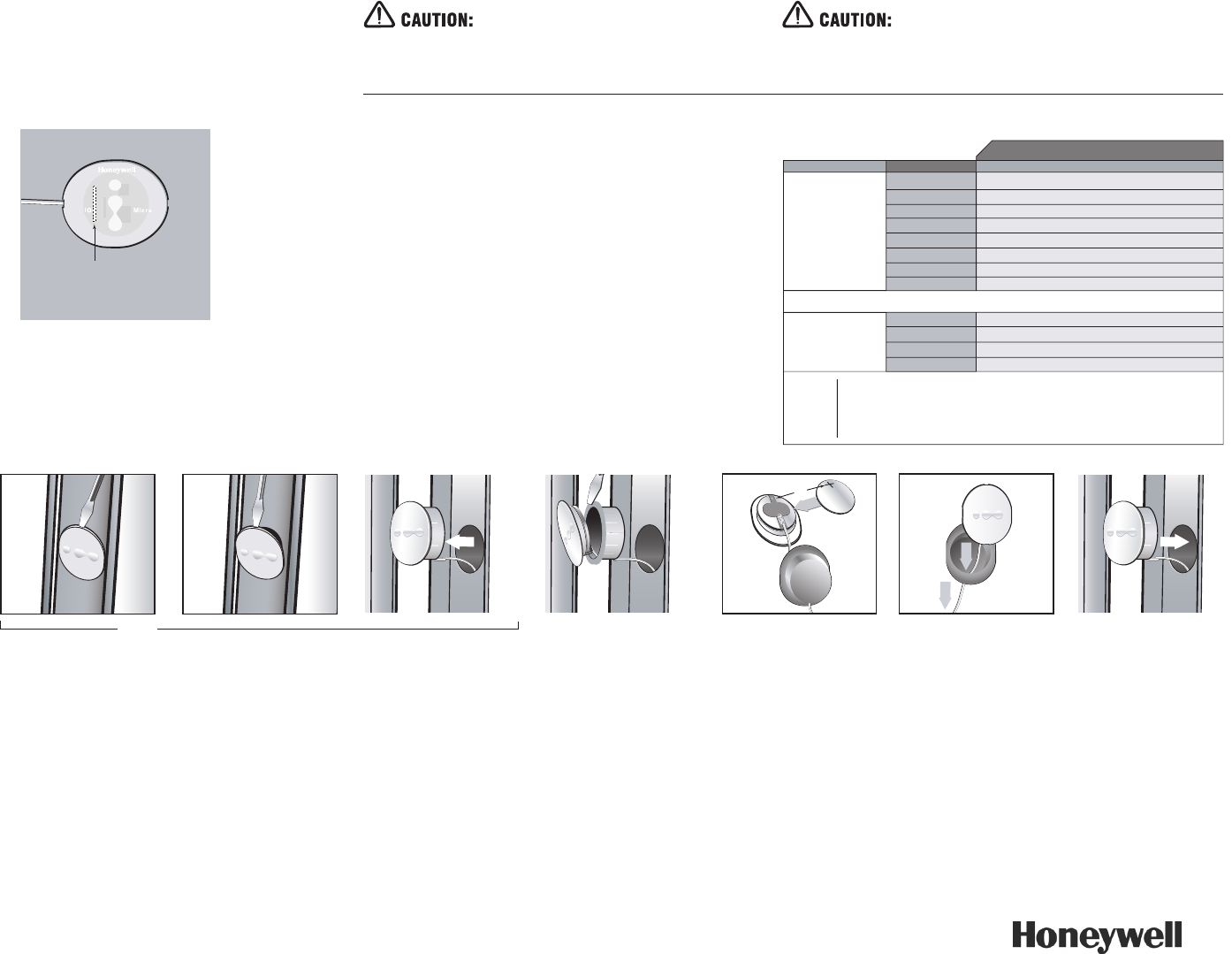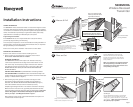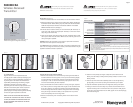
+
SPECIFICATIONS 5800MICRA transmitters
Dimensions Dowel Package 0.750" diameter (3/4")
Additional Info Dowel Lid 0.850" diameter x 0.060" thick
Wire Antenna 11" x 0.050" diameter (24 gauge)
Fits Cavity Depth 0.330" depth (11/32")
Power Source 3.0V Lithium Coin Cell Battery CR1620
Transmit Range Typically >500 ft. open air
Temperature Range 10º to 120º F (-12º to 49º C)
Operating Gap 0.5"
Compatibility Windows All Vinyl Window Types, Wood Casement, Awning,
Double-Hung and Access
IC number 4488A-5800M
FCC Identification QN35800M
MOUNTING
(See Figure 1)
1. Mark the selected location for the transmitter on the frame of the window.
2. Mark the location for the magnet on the window sash, directly opposite the
transmitter location. Before drilling any holes, make sure that the successful
Go/No Go reception tests have been conducted as called for in the 5800
MICRA transmitter section. (see Page 1)
3. Drill holes at the locations marked, for the transmitter (3/4" diameter, no
more than 11/32" deep) and magnet (3/4" diameter, no more than 11/32"
deep using a 3/4 Forstner bit).
4. lnsert the transmitter and magnet cases into their respective holes so that
their caps are flush with the surface. Make sure the antenna goes into the
cavity as straight as possible.
DO NOT hammer the transmitter or the magnet in place with hard blows.
Press them into their respective holes by hand.
The 5800MICRA uses a santaprene case that, once placed, is designed to self-
seal in the mounting hole. However, if desired, a thin bead of silicon may be
applied for additional moisture protection.
TO THE INSTALLER
Regular maintenance and inspection (at least
annually) by the installer and frequent testing by the
user are vital to continuous satisfactory operation of
any alarm system. The installer should assume the
responsibility of developing and offering a regular
maintenance program to the user, as well as
acquainting the user with the proper operation and
limitations of the alarm system and its component
parts. Recommendations must be included for a
specific program of frequent testing (at least weekly)
to insure the system's operation at all times.
REFER TO THE lNSTALLATlON lNSTRUCTlONS FOR
THE RECEIVER / CONTROL WlTH WHlCH THlS DEVlCE
lS USED, FOR WARRANTY lNFORMATlON AND FOR
DETAlLS REGARDlNG LlMlTATlONS OF THE ENTlRE
ALARM SYSTEM.
BATTERY INSTALLATION & REPLACEMENT
1. Remove the transmitter from the window by inserting the flat blade of
a small screwdriver into the pry-slot on the cap end and twisting slightly
counter-clockwise. The transmitter must be removed from the window
completely in order to refit the transmitter properly back into the hole
once the internal battery has been replaced.
2. Using the flat blade of a small screwdriver in the pry-slot again, separate
the white cap from the orange base with a slight counter-clockwise twist.
Once open, slide the cap with the transmitter PC board assembly apart
from the orange base. Pull the antenna through the hole in the orange
base just enough to allow the battery to be replaced. Do not pull the
antenna completely out of the orange base.
3. Remove the old battery from it's battery holder on the bottom of the
PC board.
4. Observe correct polarity (see Figure 3 Step 3 & 4) and insert the fresh
battery into the battery holder (positive polarity indicator is shown on the
battery holder).
5. Slide the cap with the PC board assembly back into its orange base by
gently pulling on the antenna, easing the transmitter cap into place.
6. Snap the transmitter cap back onto the orange base, locking it into place.
7. Placing the antenna into the cavity first, reinsert the transmitter into its
original mounting hole in the window. Be sure to point the 'iON' graphic
on the cap in the same direction as the 'iON' graphic on the accompanying
sash-mounted magnet.
US Patent No. 6,737,969 Copyright © 2004 Honeywell Corporation
165 Eileen Way
Syosset, NY, 11791
This device complies with FCC Rules Part 15. Operation is subject to the following two conditions:
1. This device may not cause harmful interference.
2. This device must accept any interference that may be received, including interference that may
cause undesired operation.
Changes or modifications not expressly approved by the Honeywell Corporation can void the user’s
authority to operate the equipment.
FCC
Notice
Figure 2
Before drilling any holes, make sure that successful
Go/No Go transmission reception tests have been conducted as called for in the
5800MICRA transmitter section.
BATTERY CAUTION: Risk of fire, explosion and burns.
Do not recharge, disassemble, heat above 212"F (100"C) or incinerate. Dispose
of used batteries promptly. Keep away from children.
Page 2
5800MICRA
Wireless Recessed
Transmitter
Reed Switch Positioning - insure that logos on
switch and magnet are aligned identically.
Reed Switch on
top side of PC board
(inside cap)
STEP 1 STEP 2 STEP 3 & 4 STEP 5 & 6 STEP 7
Figure 3
Printed in Canada




